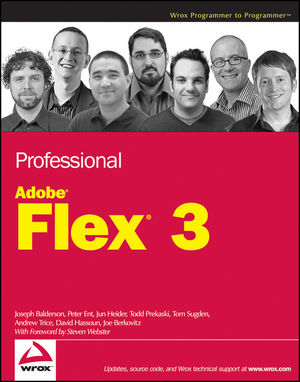Professional Adobe Flex 3ISBN: 978-0-470-22364-2
Paperback
1488 pages
June 2009
 This title is out-of-print and not currently available for purchase from this site.
|
Part I: Introduction to Flex 3.
Chapter 1: Why Flex?
Chapter 2: The Flex 3 Ecosystem.
Chapter 3: ActionScript 3.0 Fundamentals.
Chapter 4: Using ActionScript 3.0.
Chapter 5: Introduction to Flex Builder 3.
Part II: Developing with Flex 3.
Chapter 6: Using Flex Builder 3.
Chapter 7: MXML Fundamentals.
Chapter 8: Developing with Flex Builder 3.
Chapter 9: Customizing Flex Builder 3.
Part III: Working with Components.
Chapter 10: The Component Life Cycle and Class Hierarchy.
Chapter 11: Using Data Binding and Events.
Chapter 12: User Interface Controls and Containers.
Chapter 13: Layout Strategies.
Chapter 14: User Interface Integration.
Chapter 15: Getting Started with AIR.
Part IV: Advanced Component Development.
Chapter 16: Custom ActionScript Components.
Chapter 17: Custom MXML Components.
Chapter 18: Extending Flex Components.
Chapter 19: Advanced Event Programming.
Chapter 20: State Management.
Chapter 21: Using Libraries.
Part V: Visual Effects and Multimedia.
Chapter 22: Styles.
Chapter 23: Skinning and Themes.
Chapter 24: Visual Effects.
Chapter 25: Dynamic Skinning and the Drawing API.
Chapter 26: Flash Integration.
Chapter 27: Loading External Assets.
Chapter 28: Video and Sound.
Chapter 29: Advanced Flash Integration.
Part VI: Data Management.
Chapter 30: Working with Data.
Chapter 31: Formatters and Validators.
Chapter 32: Using the List Components.
Chapter 33: Advanced Data Controls.
Chapter 34: Drag and Drop in Flex.
Chapter 35: Drag and Drop in AIR.
Chapter 36: Using the Charting Components.
Chapter 37: Resource Bundles and Data Localization.
Part VII: Client Communications.
Chapter 38: Browser Communication in Flex.
Chapter 39: HTML Mashups with AIR.
Chapter 40: Deep Linking.
Chapter 41: System Interactions in Flex.
Chapter 42: Native Desktop Support with AIR.
Chapter 43: LocalConnection and Shared Objects.
Chapter 44: File Management with Flex.
Chapter 45: Local File Management with AIR.
Part VIII: Server Integration.
Chapter 46: Introduction to RPC Services.
Chapter 47: Error Handling.
Chapter 48: Flex and Flash Media Server.
Chapter 49: RESTful Web Services with Flex and the Zend Framework.
Chapter 50: Integrating Flex and Java.
Chapter 51: Web Services with .NET and Flex.
Chapter 52: Offline Data Access with AIR.
Part IX: Data Services.
Chapter 53: Introduction to LCDS.
Chapter 54: LCDS and ColdFusion.
Chapter 55: The Message Service.
Chapter 56: The Data Management Service.
Chapter 57: Advanced Data Management Services.
Chapter 58: The Data Services Stress Testing Framework.
Chapter 59: Using BlazeDS.
Part X: Using Cairngorm.
Chapter 60: MVC Frameworks.
Chapter 61: Introduction to Cairngorm.
Chapter 62: Applied Cairngorm.
Chapter 63: Advanced Cairngorm.
Part XI: Application Development Strategies.
Chapter 64: Best Practices.
Chapter 65: The Security Model.
Chapter 66: Modular Application Development.
Chapter 67: Application Performance Strategies.
Chapter 68: Project Documenting with ASDoc.
Chapter 69: Desktop Deployment with AIR.
Chapter 70: Dual Deployment for Flex and AIR.
Part XII: Testing and Debugging.
Chapter 71: Debugging Flex Applications.
Chapter 72: Using the Flex Profiler.
Chapter 73: Unit Testing and Test-Driven Development with FlexUnit.
Chapter 74: The Logging Framework.
Chapter 75: The Automation Framework.
Appendix A: ActionScript Language Comparison.
Index.



